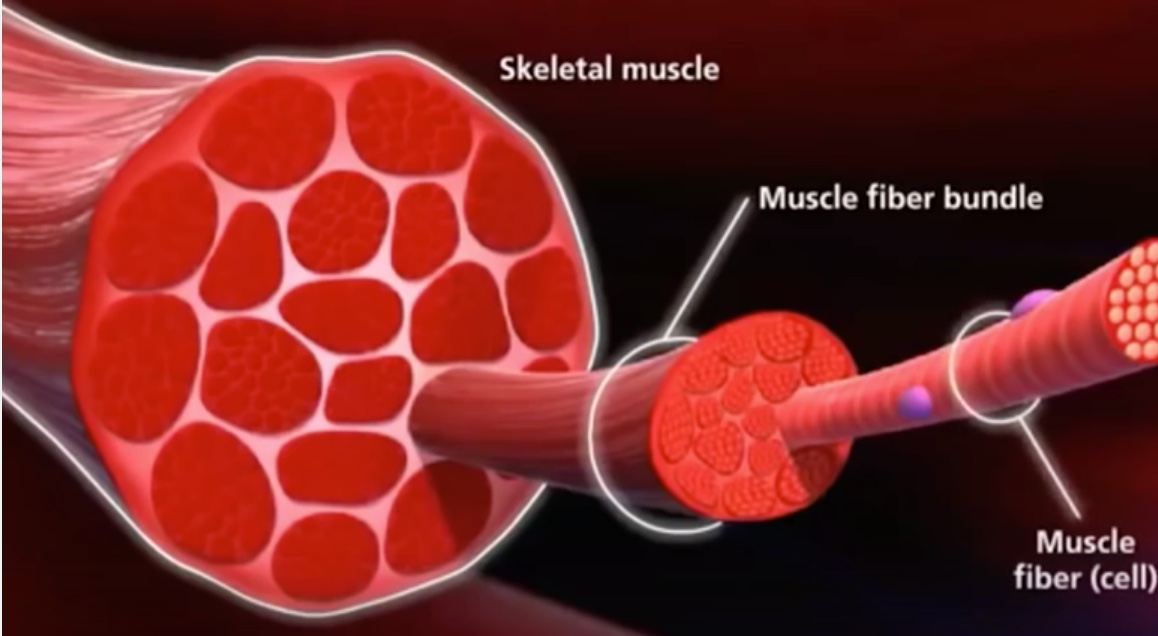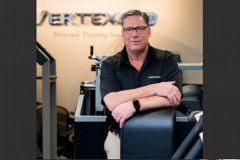How Your Muscle Fibers Work
I was talking to one of my clients the other day, and she wanted to know why we didn’t incorporate more diversity into her workout routine in order to change up what muscle fibers we were working. I realized that she didn’t know how muscle fatigue and overload work, because she didn’t understand how her muscles work in general. To understand how to build and improve your muscles, you need to understand how your muscles do work, and what makes up a muscle.
Your Muscle Fibers
The actual tissue in your muscle is made up of about 80% water, and 20% protein filaments. These “protein filaments” are the muscle fibers that move within your muscle. These fibers are arranged in cylinders, like bundles of wires encased in rubber cording. Bunches of these muscle fibers bundled together make up the muscle itself.
Your muscle fibers move by contracting, which is accomplished by the fibers sliding together and over each other. I showed my client the chapter on muscle fibers in the book Building Strength and Stamina by Wayne Westcott, PhD. According to Westcott, “The sliding action of the protein filaments is caused by electrical, chemical, and mechanical interactions. The electrical stimulus for muscle contraction comes from a motor nerve located in the central nervous system. The motor nerve branches into many nerve endings, eac of which attaches to a different muscle fiber.” (Building Strength and Stamina: New Nautilus Training for Total Fitness, pg. 20)
I explained to my client that three things happen when your muscles moves: your brain sends an electrical signal to tell it to move, your muscle releases stored chemical energy to do the work, and your muscle acts mechanically against your bones to provide the force against whatever you’re trying to move.
The electrical component begins the whole process when an electrical signal is sent from your brain through your nervous system to the individual nerve that is attached to the muscle fibers that your brain is trying to activate. When the signal reaches the muscle to tell it to contract, a chemical reaction takes place in your muscle when ATP is broken down, creating chemical energy that is used to create the force that moves the muscle. That’s what allows the mechanical action of your muscles fibers sliding against one another to contract the muscle, which pulls against your bones, which moves your limbs, which pushes against the weight that you are trying to pick up.
Muscle Fiber Misconceptions
There are a few key factors here that not only my client, but almost everyone gets wrong when they think about how their muscles act and move. The first is that your brain makes decisions, not your muscles. That’s why changing up your exercise routine just for the sake of doing so won’t make your workout more effective. Your muscle fibers only contract and fire when your brain tells them to, and the fibers themselves can’t actually give half of an effort, no matter how many times you’ve done an action before.
Your brain only tells your individual muscle fibers to either fire or not fire–they only speak a binary language. Rather, to control the amount of force you use, your brain instead controls how many muscle fibers are activated, not how much they contract. Therefore, to pick up a pen, only a few muscle fibers will be activated by your brain. To pick up a hundred pound weight, your brain will fire more muscle fibers. This is why “Muscle Confusion” is a myth, which I discuss in greater detail elsewhere on my blog.
What my client thought would be accomplished by changing up her routine is actually accomplished through repeated action on the same muscle groups. If you go to pick up that hundred pound weight a second time, your brain will try to fire all of the same muscle fibers again, but some of them will be fatigued, and may not be able to generate full force. This will force your brain to recruit more muscle fibers. The more fibers you can recruit, and then fatigue, the more effective your workout will be. In order to effect change in your muscles to make them bigger and stronger, you must work them to overload.
Physiological Overload in Muscles
Once she understood that the muscles needed to be subjected to repeated action, she wanted to know why she couldn’t do a much lower weight many more times. This brought our discussion to the concept of physiological overload. This idea is explained well by my friend Matt Brzycki in A Practical Approach to Strength Training. He says that “Any type of physical training – whether it’s done for anaerobic, aerobic, strength, flexibility, metabolic, power or skill improvements – must incorporate a well-known foundational concept in exercise science called the Overload Principle. The term overload means that a targeted physiological and/or neurological system is made to work harder than it’s accustomed to working. This suggests that there’s a minimum threshold that must be surpassed before a specific, long-term adaptation is produced.” (A Practical Approach to Strength Training Vol. 4, pg. 15)
That minimum threshold will never be reached by my client if I were to simply allow her to lift five-pound weights all day long. The long-term adaptation mentioned by Brzycki is muscle growth, and the only way to get there is to push your muscles to the point of maximum effort. In order to change, your muscles need to be overloaded. To do that, you need to do enough mechanical work to recruit enough of your muscle fibers and drive them to fatigue through repeated action.
My client had one of her best ever sessions after our conversation, because she was able to visualize what was happening in her muscles, understand what we were trying to achieve, and comprehend how we were going to do it. It’s critical to not only understand what you are trying to do with your muscles when you work out, but what is actually happening inside the muscles themselves while you exercise.
Related Posts
Request a complimentary first session at Vertex Fitness, Voted the BEST Personal Training Studio on the Main Line
Click HERE and we will schedule a session to try it yourself
.










Emma Oko
December 17, 2016 7:45 amAs a PT I couldn’t resist clicking on the link to this blog. I’m glad I did! Its really well written and you’ve managed to bring one of my favorite subjects (muscles) to life. Nice job!
Dwayne Wimmer
December 17, 2016 1:38 pmHello Emma,
Thanks for your comment on our Muscle Fiber post. We take this stuff very serious and want to help others understand it so they will know how to use the information and get the benefits they can from it.
Thanks again for your reply.
Dwayne Wimmer
Owner
Vertex Fitness Personal Training Studio